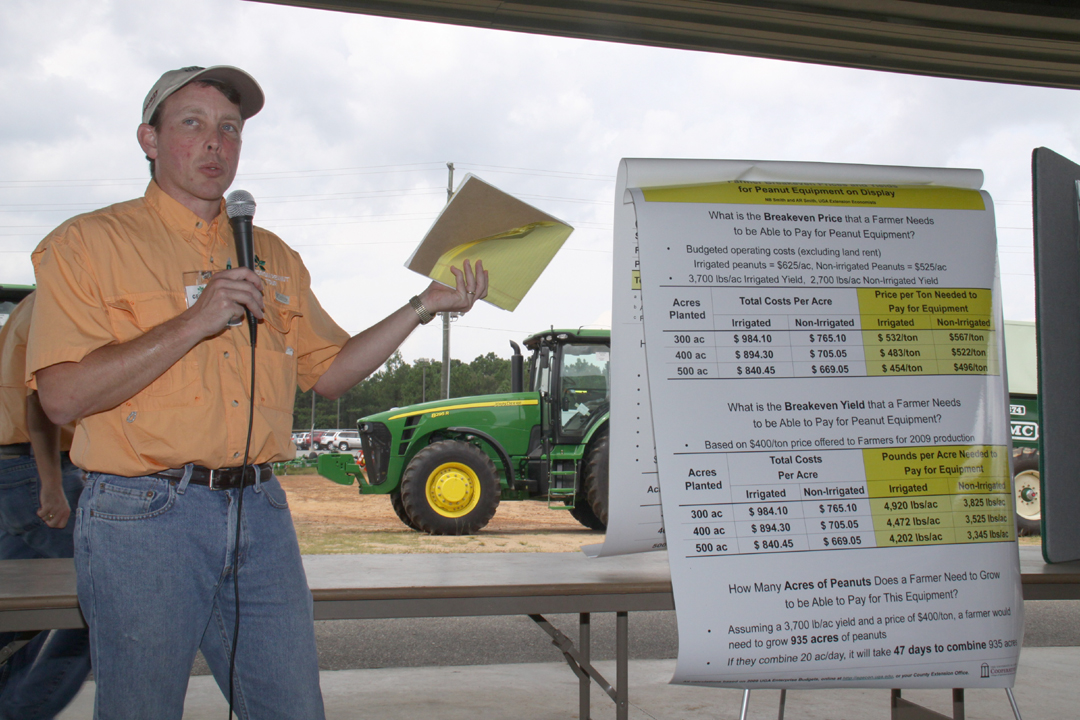James Jacobs, University of Georgia Extension coordinator, provided an update on the Georgia Peanut Tour regarding peanut production in Pierce and Ware County. Both of these counties have seen a reduction in peanut acreage and a shift in acreage to soybeans. This year Pierce County farmers planted 6,000 acres and Ware County farmers planted 1,000 acres. Many acres were planted late due to rains in May. He says, farmers in this area have had trouble with white mold but overall the crop is looking fair and many farmers will begin harvest in October.
Author: joycrosby
Appling & Wayne County Agriculture Update
Mark Frye, University of Georgia Extension county agent, provided an update on agriculture in Appling and Wayne County during the Georgia Peanut Tour. Peanut acreage decreased in these counties due to price and market situation. According to Frye, it was very dramatic decreasing from 17,000 acres in 2008 to 9,500 in 2009. The majority of acres shifted to cotton and soybeans. The crop this year started out extremely wet since the counties had a record rainfall in May. According to Frye, both counties had pretty decent rainfall this year until the last few weeks. In Wayne county farmers have experienced a little more army worm pressure in their peanuts than in Appling County. Appling County ranked 23rd in 2008 of total farm gate value out of 159 counties.
Dodge County Agriculture Overview
Furman Peebles, Dodge County Extension Coordinator, provided tour attendees with an overview of peanut production in the area. There are 3,800 acres of peanuts grown in the county with 90% strip tilled and 3,000 acres irrigated. According to Peebles, approximately 530 acres of peanuts will be sold as green peanuts for boiling by Hardy Farms. He predicts yield to range from 3,400 to 3,500 pounds per acre for peanuts. Growers in the county have had problems with dry weather and the heat in June and trouble with white mold. Cotton is also grown in the county and farmers planted 13,000 acres this year.
Wheeler County Agriculture Overview
Mike Hayes, Wheeler County Extension Coordinator, provided information to the Georgia Peanut Tour attendees regarding agriculture production in Wheeler County. He says, peanut acreage is about half of what it was 20 years ago. Peanut acreage for 2009 is 786 acres with 90% irrigated and 100% strip tilled. Growers have had several problems this year with weed control and cost of production. The county is still in the peanut business mainly for rotaton with cotton. Wheeler County has also lost some of their peanut infrastructure in the county by losing the local peanut buying point. Soybeans is the counties largest crop followed by cotton and corn. Many farmers have also diversified by growing snap beans, watermelon, cantaloupe and other vegetables.
Laurens County Agriculture Overview
Laurens County Extension Coordinator, Raymond Joyce, says the peanut crop in Laurens County looks good this year. Peanut acreage in the county continues to decline and shifting to soybean acreage and longleaf pine. The total peanut acreage for 2008 was 3,923 acres and the 2009 acreage for the county is even less at 1,654 acres. The drop in the number of farmers growing peanuts has also declined from 40 to 50 down to 10 or less growers. Peanut farmers have faced production issues with controlling herbicide resistant weeds, high input prices, and low commodity prices. Farmers in Laurens County also grow soybeans, corn, cotton, and hay.
Telfair County Agriculture Overview
Jack Wall, Telfair County Extension Coordinator, provided info to the Georgia Peanut Tour attendees on peanut production in the area. He says the peanut crop in Telfair County looks good this year. There are 2,600 acres of peanuts planted this year which is almost half of the peanuts planted in 2008. The majority of peanuts are strip-tilled following a wheat cover crop. Sixty percent of peanuts in Telfair County is planted on irrigated land. Weed pressure is getting greater and greater and most growers are continuing to have problems with pigweed. Wall estimates yield at 3,500 pounds per acre in the county.
Tour visits Weather Station

Rabiu Olatinwo, University of Georgia
The Georgia Peanut Tour stopped at the Georgia Automated Environmental Monitoring Network weather station in McRae, Ga. The AEMN was established in 1991 by the University of Georgia College of Agricultural and Environmental Sciences and collects detailed weather information and other environmental variables across the state of Georgia.
There are 77 automated weather stations across Georgia. Each weather station monitors relative humidity, air temperature, soil moisture, soil temperature at three different depths, wind speed and direction, solar radiation, barometric pressue, and precipitation. Some stations also monitor open pan evaporation, water temperature and leaf wetness. The data is scanned at a one-second frequency and every 15 minutes a summary is calculated and stored in the data logger. The data is downloaded into a computer at the UGA Griffin Campus and once it is processed, the data is made available for the public to view online at www.georgiaweather.net. The data is used for irrigation management, water conservation, integrated pest management, precision farming and more.
Rabiu Olatinwo with UGA explains more about the weather station.
From Peanuts to Peanut Butter

Jeff Davis 4-H members with Marcus Evans of the Georgia Peanut Commission.
Georgia Peanut Tour attendees were able to learn about an educational program in Jeff Davis County which is helping to teach youth more about peanuts and the importance of this crop to their local economy. Jeff Davis County Extension Agent Sheila Marchant decided to organize this educational program after peanut acreage in the county increased from 1,700 to 10,120 acres in a two year period.
The program seeked to raise awareness of peanuts as a cash crop among Jeff Davis County youth, utilize the maturity classification procedure and its impact at harvest time and classify uses of peanuts for human consumption and processing. To meet these objectives Marchant held a series of activities to raise awareness regarding peanuts in the county for children (pre-school to 6th grade) enrolled in the local home school program. Classes were held for the Home School using hands-on activities to teach the value and uses of peanuts. Students learned how to determine peanut maturity, made Old Fashioned peanut butter and created a peanut exhibit for the local county fair.
Fifteen students created and displayed six exhibits at the Jeff Davis County Agricultural Fair that were seen by 5,000 visitors during the week. The display, “Peanuts to Peanut Butter” received Best of Show Award at the fair. The display focused on the quantity of peanuts grown in Georgia and how they are used in making peanut butter.
View additional information regarding Peanuts to Peanut Butter.
Peanut Equipment at Lasseter Implement Company

Nathan Smith, University of Georgia
The Georgia Peanut Tour visited Lasseter Implement Company in Hazlehurst, Ga. to learn more about the equipment farmers use to produce quality peanuts and the investments made by each farmer when purchasing the equipment. University of Georgia economist Nathan Smith presented information on a farmer’s investment and operating costs for peanut equipment. According to Smith, if a farmer purchases a tractor (200 hp, 4 Wheel Drive), six-row digger, four-row combine and peanut dump cart their total investment is approximately $325,000. This is a large investment for a farmer since the only piece of equipment, the tractor, can be used with other crops. If a farmer is growing 300 acres then they would need $532 per ton on irrigated peanuts and $567 per ton on non-irrigated peantus to breakeven and be able to pay for the equipment. The same farmer growing 300 acres would need to yield 4,920 pounds per acre on irrigated peanuts and 3,825 on non-irrigated peanuts to breakeven and be able to pay for the equipment.
So, how many acres of peanuts does a farmer need to grow to be able to pay for this equipment?
• Assuming a 3,700 lb/ac yield and a price of $400/ton, a farmer would need to grow 935 acres of peanuts
• If they combine 20 ac/day, it will take 47 days to combine 935 acres
John Hayes with Lasseter Implement Company provides overview of the company on the Georgia Peanut Tour.
2009 Peanut Acreage Report
Stanley Fletcher, University of Georgia ag economist and director of the National Center for Peanut Competitiveness, provided an overview on the tour regarding peanut production across the U.S. According to the September 11, 2009, crop production report by USDA’s National Agricultural Statistics Service peanut production is forecast at 3.68 billion pounds, down 29 percent from 2008. For 2009 planting was delayed by several weeks due to wet weather during the month of May. During this past year with the farmers checkoff money in organizations like the Georgia Peanut Commission and the National Peanut Board, we did not see the drop in peanut butter usage as one would have predicted due to the salmonella recall, Fletcher says. These checkoff organizations were able to help with marketing efforts and promoting peanuts and peanut butter.
2009 Georgia Peanut Production Map
2009 Southeast Peanut Production Map
